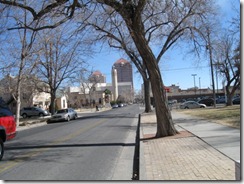 |
| Northwest Albuquerque |
Did the Albuquerque, New Mexico real estate market fare better or worse in 2010? You be the judge. The headliner statistics summarized here are provided with kind permission of The Greater Albuquerque Association of Realtors (GAAR) to help you decide.
January: Closed sales are up 7.72 percent from January 2009. Pending sales are up 28.60 from 2009 and increased 55.46 from previous month, December 2008. Average sale price is $205,624, down 4.30 percent from January 2008. Median sale price is $172,240 (down 1.58 percent from January 2009). Active listings number 766, down 10.23 percent from January 2008. It takes an average of 81 days to sell a house (down 3.57 percent from the previous January).
February: Home sales up 10.79 percent from February 2009 and 8.88 percent from previous month. Pending sales are up 46.98 percent. Rio Rancho shows significant improvements compared to February 2009 with 37.35 percent increase in homes sales and 104.11 percent increase in pending sales.
March: Significant increase in single-family home sale. They are up 36.34 percent from March 2009 and 66.84 percent from previous month. Prices are higher than in previous month but are still lower than in March 2009.
April: Highest number of single-family-detached homes reported sold in any April since 2007. Home sales pass the 1,000 mark second time this year. Median sale price of single-family-detached homes is holding steady at $175,000. The average sale price falls from $206,070 in April 2009 to $205,601 in April 2010. Compared to the previous month, March the average price of a home fell approximately $6000.
May: Highest number of May sales since 2007. Sales in some areas of Albuquerque are up 28.09 percent above May 2009 sales. For the same period, Rio Rancho sales rise 37.08 percent
June: Home sales increase 11.40 percent above June 2009 but decline relative to the previous month. Median sale price climb to $181,000, the highest monthly median sales price since August 2009.
July: Pending sales decrease 14.06 percent. Closed sales decrease 24.22 percent. The median sale price rises 0.54 percent. The inventory of homes for sale increase 5.97 percent. There are 5,083 single-family-detached homes for sale.
August: Home sales decline. Pending sales rise 2.3 percent from previous month. Median sale price declines 1.88 percent from previous year and month.
September: Compared to 2009, pending sales are down 28.82 percent, closed sales are down 2.52 percent, and average sale price is up 3.66 percent. Median sale price is also up 1.72 percent.
October: Pending sales are 1 percent lower than in September. Pending sale price sees year-over-year increase two months in a row. Average sale price is 7.66 percent and median 5.88 percent above October 2009 prices.
November: Closed sales up 2.85 percent; the first time since 2005 that sales increased from October to November. Median sale price shows year-over-year increase for third consecutive month. The average sale price is $220,453, up 5.36 percent from November 2009. The median is $177,500, up 1 percent. In all, 5,110 single-family detached homes are actively listed for sale, 5.71 percent more than in January 2009. It takes an average of 79 days to sell a home.
December: Statistics are not yet available for December 2010 sales but we know that the December 2009 average sale price was $216,687 and the median, $175,875. Sales numbered 543 and properties pending sale, 476. Then, we had 4,630 active listings on the market and it took an average of 83 days to sell one of them.
Year-Over-Year: The current November median sale price is lower than it was in November 2008 when it was $189,000 but the average is higher. In November 2008 it was $212,088.
How did you decide?
The overall market trend seems set for the year. Ii is inconceivable that events or forces dramatic enough to significantly alter it could occur during the ten remaining days of the year. Was the Greater Albuquerque, New Mexico real estate market better or worse in 2010? Cast your vote on this site.
Eloise Gift
Gift Realty NM
(505) 363-5156











 Within a relatively short time, the word “green” has come to be as widely understood as a way of life as of a color. The new definition, synonymous with sustainability, environmental and ecological sensitivity embodies the defining attribute of our planet as a healthy life supporting environment. It is generally accepted that losing the green attribute of earth means losing quality of life as we know it.
Within a relatively short time, the word “green” has come to be as widely understood as a way of life as of a color. The new definition, synonymous with sustainability, environmental and ecological sensitivity embodies the defining attribute of our planet as a healthy life supporting environment. It is generally accepted that losing the green attribute of earth means losing quality of life as we know it. 

















